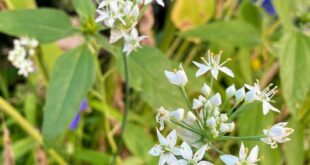Indian hawthorn (Rhaphiolepis sp.) is prized as a small, low-maintenance shrub or ground cover native to southern China and Japan and cultivated across U.S. Department of Agriculture plant hardiness zones 8 through 11. Various cultivars of Indian hawthorn offer attractive foliage, white to pink flowers and a slight range in available plant sizes.
This plant is attractive to bees, butterflies and/or birds
Site and Soil Preferences
The Indian hawthorn prefers a site in full sun or partial shade. This shrub can tolerate sandy soil and salt spray, making it appropriate for coastal plantings. Indian hawthorns will thrive in a range of soil types but prefer a moist, well-drained soil. Although these plants benefit from regular water when young, they are moderately drought-tolerant once established.
Form and Growth Habit
Most Indian hawthorn cultivars grow 3 to 6 feet tall with a similar size spread. This shrub is an evergreen with a dense mounded or round shape. The foliage is clustered at the ends of numerous branching stems, helping this plant to achieve its dense appearance. A few cultivars are larger shrubs, potentially trained to have the appearance of a small tree.
Foliage, Flowers and Fruit
Indian hawthorn leaves are dark green, leathery and measure 2 to 4 inches long with a slightly rounded shape. Older leaves may turn a crimson red and drop off in fall and winter. Indian hawthorn flowers are white or pinkish, about one-half-inch wide, and appear on loose terminal panicles in late winter or spring. A less impressive bloom period may occur in fall. The flowers regularly mature into small purple or bluish fruits that are attractive to birds.
Landscape Uses and Care Requirements
The low-growing, dense nature of the Indian hawthorn makes it ideal for foundation plantings as a large-scale ground cover or as a low, informal hedge or divider. Although this plant is fairly drought tolerant, it will benefit from weekly irrigation during hot, dry weather. While Indian hawthorn can tolerate pruning or shearing, it will bloom most prolifically and appear at its best with minimal trimming.
Details
Genus: Rhaphiolepis (raf-ee-oh-LEP-iss) (Info)
Species: indica (IN-dih-kuh) (Info)
Synonym:Raphiolepis indica
Category: Perennials, Shrubs
Height: 4-6 ft. (1.2-1.8 m)
Spacing: 4-6 ft. (1.2-1.8 m)
Hardiness: USDA Zones 7 to 11
Sun Exposure: Sun to Partial Shade
Danger: Unknown – Tell us
Bloom Color: Pale Pink
Bloom Time: Mid Spring, Mid Fall
Foliage: Evergreen
Other details: Average Water Needs; Water regularly; do not overwater
Soil pH requirements: 6.1 to 6.5 (mildly acidic)
Patent Information: Unknown – Tell us
Propagation Methods: From semi-hardwood cuttings; From seed; sow indoors before last frost; From seed; direct sow after last frost
Seed Collecting: Remove fleshy coating on seeds before storing. Seed does not store well; sow as soon as possible
Read more: http://davesgarden.com/guides/pf/go/51731/#ixzz3I7yFgiCV








